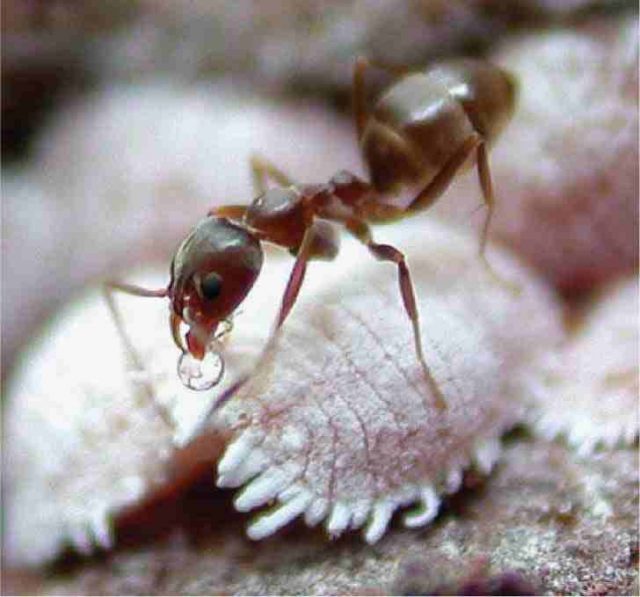Defend your friends
Mutualistic interactions are ubiquitous phenomena occurring between many classes of organisms. The mutually beneficial relationship between ants and honeydew-producing mealybugs (hemipterans) is a very well-studied example. Mealybugs belong to the family Pseudococcidae and they are unarmored scale insects found in moist and warm climates. The ants collect and exploit the honeydew produced by the mealybugs and this food resource is important for them because it contains sugars mixed with various amino acids and energy-rich materials. The ants, in return, protect the hemipterans and therefore, the survival and persistence of populations from both species can be strongly enhanced by the presence of their mutualistic partners.

One of the most studied mutualistic association is the relationship between the solenopsis mealybug, Phenacoccus solenopsis Tinsley (Hemiptera: Pseudococcidae), and different ant species such as the red fire ant Solenopsis invicta Buren and the ghost ant Tapinoma melanocephalum (F.). In the laboratory, ant colony growth increased significantly when ants had access to the hemipterans. The ants tend the honeydew-producing insects, an activity that has a clear impact on the mealybugs. Colony density of P. solenopsis was significantly greater on plots with ants that in plots without ants. The ants reduce the mortality risk of fungal infection, and they enhance hemipteran colonies by the stimulation of feeding and honeydew excretion.
In the field, ant tending increases the densities of the mealybug and reduces the densities of the mealybug’s predatory and parasitic enemies, the lady beetle, Menochilus sexmaculata Fabricius (Coleoptera: Coccinellidae), and the parasitoid wasp, Aenasius bambawalei Hayat (Hymenoptera: Encyrtidae). Mealybugs tended by ants matured earlier, life longer, increased their reproduction rate and had a higher number of offspring than hemipterans that were not tended by ants. It has been demonstrated that more ants foraged on mealybug-infested hibiscus plants than on mealybug-free plants. The number of foraging ants on plants infested with high densities of mealybugs (62.5 ants per plant) was nearly six times that on mealybug-free plants (10.2 ants per plant)1. The mutualism facilitates population growth and fitness in both species.
Mealybugs are considered pests as they feed on plant juices of greenhouse plants, house plants, and subtropical trees and also act as a vector for several plant diseases. Phenacoccus solenopsis is an invasive species native to North America that has become a cosmopolitan pest of cotton. It spread to Asia in 2005 and caused serious damage to harvests in Pakistan, India and China. Yield loss estimates due to P. solenopsis infestations in cotton were 1.4 million tons in China in 2008/2009. A team from the South China Agricultural University in Guangzhou (China) has studied the interactions between ants and mealybug trying to stop the expansion of this pest. (2)(Feng)
Biological control has been considered to reduce this damage and several parasitoid species have shown clear potential for limiting the expansion of the pest. One of the most interesting species is Aenasius bambawalei Hayat (Hymenoptera: Encyrtidae), a solitary parasitoid of P. solenopsis, which has shown promise suppressing populations of the mealybug in the three invaded Asian countries where losses are higher. However, a problem has been detected: mutualistic interaction with local ants. Tapinoma melanocephalum, a local species, improves the survival on the invasive mealybug, by defending it from parasitoids2. The same has been reported by the invasive red fire ant thus mutualism between these two alien species, the fire ant and the solenopsis mealybug may facilitate the invasion success of both species 3.
When A. bambawalei was present, the presence of ants resulted in larger numbers of P. solenopsis at the end of the experiment than in their absence, a proof of the success of the mutualistic interaction. Ants attacked parasitoids, but parasitoids did not attack ants and spent more time in avoidance or escape behaviors. When the parasitoid was excluded, there was no difference in survival rate of mealybugs between ant-tended and ant-excluded plants. Therefore, if not for the shielding mechanism, A. bambawalei would be a good option to stop the expansion of P. solenopsis and to limit its damages.
This is not the first evidence of ants protecting their mutualistic partners. It is known that they act as guardians of aphids, protecting them from predators and parasitoids and also shelter butterflies. Feng and his coworkers conclude that native ants such as T. melanocephalum have the potential to facilitate invasion and spread of P. solenopsis in China by providing them with protection from parasitoids. Bad news.
References
- Zhou A, Lu Y, Zeng L, Xu Y, Liang G (2013) Solenopsis invicta (Hymenoptera: Formicidae), defend Phenacoccus solenopsis (Hemiptera: Pseudococcidae) against its natural enemies. Environ Entomol 42(2): 247-252. ↩
- Feng DD, Michaud JP, Li P, Zhou ZS, Xu ZF (2015) The native ant, Tapinoma melanocephalum, improves the survival of an invasive mealybug, Phenacoccus solenopsis, by defending it from parasitoids. Sci Rep 5: 15691. ↩
- Zhou A, Lu Y, Zeng L, Xu Y, Liang G (2012) Does mutualism drive the invasion of two alien species? The case of Solenopsis invicta and Phenacoccus solenopsis. PLoS One 7(7): e41856. ↩